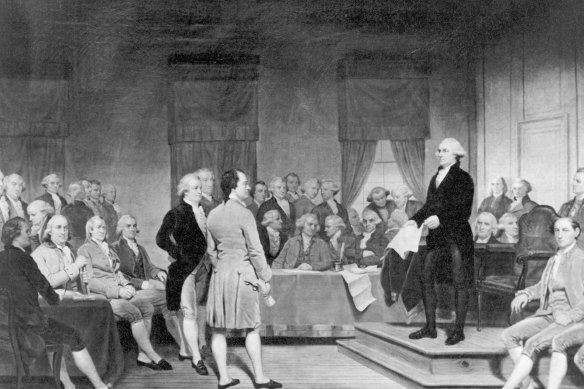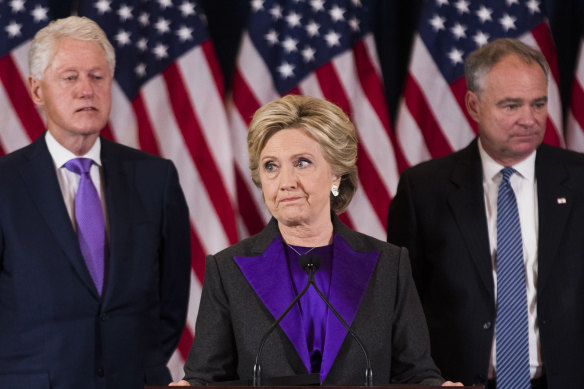Explainer
- Explainer
- US votes 2020
Complex, quirky, confounding: How does voting for the US president work?
Designed to balance the passions of the masses against the better judgement of the elite, the Electoral College has infuriated, outraged – and endured. How does this process work? Why was it made this way?
It's been labelled a "disaster for democracy", a "great anomaly" and an "antiquated mechanism". But the Electoral College, an arcane voting arrangement originally devised in 1787 and amended in 1804, also has its supporters – and it remains the voting system of choice for the United States.
In the late 18th century the fledgling US boasted voter numbers just shy of 4 million. In a time before internet, television or radio, their focus was usually more local than voters' today. The Founding Fathers wanted to ensure that the passions of crowds didn't put the wrong kind of candidate in the highest office in the land.
"A small number of persons, selected by their fellow citizens from the general mass, will be most likely to possess the information and discernment requisite to such complicated investigations" of choosing the president, according to a document attributed to Alexander Hamilton.
So they decided that their national leader would have to have secured the vote across a number of states and, ultimately, be elected by a small number of "electors" voting in an Electoral College.
Today, the resulting system has been criticised for making the popular vote at times irrelevant in who gets the top job – and not just by Donald Trump, who called it a "disaster" in 2012.
"Every vote matters," Democratic Senator Elizabeth Warren has said, "and the way we can make that happen is that we can have national voting, and that means get rid of the Electoral College.” It was the college system that led to Democratic candidate Hillary Clinton losing the 2016 election – even though more than half of Americans who cast a ballot voted for her.
This year, as many as 145 million Americans are expected to vote in a population of 328 million – voting is not mandatory. President Donald Trump and former vice-president Joe Biden face off in the contest for the White House, and voters will also choose all 435 seats in the House of Representatives and 33 Senate seats – known as “down ballot” races.
The US system of voting for president can be mystifying to those of us raised with Westminster politics. What happens in the final stretch on the road to the White House? What is a "blue shift"? Could we face a "contingent election" in November? And how does the Electoral College work?

The signing of the Constitution of the United States, which sets out the Electoral College system of voting, in 1787.Credit: Getty Images
Where are we up to now?
So far, we’ve watched the Democrats settle on a nominee to take on Trump. Biden surprised many by becoming the frontrunner on the Super Tuesday primaries in March. He didn’t become the official candidate until August, when both he and Trump were nominated at their parties’ respective national conventions, which were "virtual" because of the coronavirus pandemic.
With debates between Trump and Biden, as well as Vice-President Mike Pence and Biden’s running mate, Senator Kamala Harris, now happening, we'll see feverish campaigning followed by the election itself on November 3. Postal voting is now underway in many states. It's after the election that the work of the Electoral College begins.
What is the Electoral College?
Despite its name, the Electoral College is a process, not a place. Laid out in Article II, Section I of the US Constitution, the college is the mechanism for electing the president.
It goes like this: the public votes on Election Day for their preferred candidate, on a statewide basis.
There are 50 states plus the District of Columbia (home to the capital), all states have two senators and a number of representatives in Congress proportionate to a state's population. The candidate who gets the most votes in each state gets to send their "electors" to the Electoral College, where the official count occurs.
Each state gets one elector for each senator and one for each representative they have in Washington. Consider Texas. It has 36 people in the House of Representatives (proportionate to its population) and two in the Senate (as with all states). It therefore has 38 electors in the Electoral College.
The map of the US Electoral College shows the patchwork of states, each with a fixed numbers of “electoral votes” – 538 in total. A presidential candidate needs 270 electoral votes to win, or one more than 269 (which is half of 538).
The popular vote for candidates in November is won in the states on a plurality basis – whichever individual gets the most votes in each state wins. Once a candidate wins in a state, his or her party gets to pick all the electors from his or her state who will go on to vote for the presidential candidate in the Electoral College ballot, in Congress. (Maine and Nebraska are exceptions as they divide their electoral votes based on a proportional system.)
The controversy arises when a candidate wins the Electoral College but loses the national popular vote. (More on this later).
Being primarily a winner-take-all contest, the Electoral College prevents third parties from gaining ground. In 1992, businessman Ross Perot ran a high-profile campaign and won nearly 19 per cent of the popular vote – but he received no Electoral College votes. (Perot went down in history for his warning about free trade deals, saying they would cause a "giant sucking sound" of jobs leaving the US – one of the issues Trump successfully exploited in 2016.)
The Electoral College is also set up to help ensure a decisive victory – or it should, at least. This is in contrast with Australia’s Westminster system in which voters cast ballots for their own electorates and multiple parties can form governing coalitions, the leader of the majority party in Parliament being the prime minister.
Typically, not long after election night in the US, we generally know who has won the presidential election, based on exit polling. But don't expect this year to be typical. With an anticipated record voter turnout – a lot of it by mail amid the pandemic – and with possible efforts by "foreign actors" and "cyber criminals" as well as by the US President to undermine faith in the vote, confusion between the election night result and the final votes could set in.
The president and vice-president are not official until the rest of the Electoral College process takes place.
If those final votes determine the electoral votes of a swing state, the outcome could become volatile. (Trump has, for the record and against historical precedent, suggested results must be known on election night.) Official vote counts are not completed sometimes for days afterwards.
While much of the rest that follows in a presidential election is a formality, the president and vice-president are not official until the rest of the Electoral College process takes place.
This actually happens in mid-December, when electors from each state cast their ballots for president and vice-president. On January 6, at 1pm, before a joint session of Congress, the votes of those electors are counted and the new president’s name is announced by the president of the Senate (who is always the incumbent vice-president). The inauguration of the president is scheduled for January 20.

Hillary Clinton concedes the presidential election supported by her husband, former president Bill Clinton and her running mate, Tim Kaine, in 2016.Credit: Getty Images
Who gets to be an elector? And what's a 'faithless' one?
Electors, who have the duty of voting in the Electoral College, are nominated by either the Democrat or Republican state party committee in the state's legislature. The Constitution doesn't specify criteria for electors other than that they can't be a Congress member or high-ranking official and that they must be loyal to the US – the Founding Fathers didn't forsee the powerful role of parties in modern America, with electors being chosen along party lines. The nominations often go to politically active party loyalists after long years of service.
Generally, electors can be counted on, or at least compelled to, vote for the candidate the decides on. But nothing in the Constitution actually requires electors to vote in line with the wishes of the party – even though they almost always do. When an elector does fail to vote as the party wishes, he or she is known as a "faithless elector".
Unlike with Westminster politics, in which party loyalty is the mechanism for advancement, in the US there is historically less party discipline.
Some states try to avoid this by requiring that electors heed a party's wishes, either through law or pledges or even threats of a penalty. And "faithless electors" remain pretty rare. There was one in each of these elections, who defied their parties to vote for a different candidate: 1948, 1956, 1960, 1968, 1972, 1976, and 1988. In 2000, one elector cast a blank ballot.
In 2016, there were two faithless voters on the Republican side, both from Texas (one who voted for congressman Ron Paul, and one who voted for Ohio governor John Kasich); and five on the Democratic side (one who voted for Bernie Sanders, three for former secretary of state Colin Powell and one for Native American politician Faith Spotted Eagle).
Unlike with the Westminster system, in which loyalty helps structure the party and the politics, in the US there is historically less party discipline. This helps explain how Trump, an outsider to the Republicans, could so effectively take over the party. Until recent years and the phenomenon of Trump, the political culture has been more tolerant of dissent and outside candidates.
What if there is a tie in the Electoral College?
A tie in the Electoral College would force the House to vote to settle the contest. Known as a "contingent election", each state's delegation casts a single vote. State delegations are the grouping of representatives elected to Congress from each state. Although Democrats control the House with 232 representatives to 198, Republicans control more state delegations, 26, versus 22 for Democrats, plus two states in which there is no outright majority.
For this reason, House Speaker Nancy Pelosi has warned Democrats of the need to pick up more Congressional seats in November to thwart any Republican plans to win a "contingent election". “It’s sad we have to have to plan this way, but it’s what we must do to ensure the election is not stolen," she said.
The last time a contingent election happened was 1800 and 1824, with the vote of 1876 also determined partially by Congress – but this doesn't mean it can't happen again.
Contrast this with the Westminster system, in which a vote that results with no particular majority or governing coalition is a hung parliament. If no governing coalition can be formed, a second election can be called. But in the US, recent experiences show that legal challenges to votes will be lodged. The US system has no “caretaker” mode.
So the winner of the popular vote becomes president?
Not always. Twice in the past 20 years, the popular vote winner has lost the Electoral College. The disconnect between the popular vote and the electoral vote is a source of growing controversy – likely driven by the frustration of the losing party, which has been the Democrats in both 2000 and 2016, and by the increasingly cut-throat attitude toward winning shown by Republicans well before Donald Trump became president.
In 2016, Democrat Hillary Clinton received 2.8 million more votes than Donald Trump, but Trump received 304 electoral votes to Clinton's 227. If Clinton had won Michigan, Wisconsin and Pennsylvania, she would have won 46 more electoral votes to secure the presidency with a total of 274. Instead, Trump won Michigan, Wisconsin and Pennsylvania with a combined margin of just 79,000 votes.
In 2000, Democratic candidate Al Gore received 500,000 more votes nationwide than Republican George W. Bush. The TV networks called the election for Gore, but then for Bush, then Gore requested a recount. The national spotlight turned on Florida; the winner would be decided in that state. Over the following five weeks, lawsuits were filed, recounts undertaken and hanging chads – the bits of paper punched out from ballots – were scrutinised. Finally, the disputed vote in Florida made it to the Supreme Court, which voted along party lines to essentially stop the recount, handing the election to Bush. Bush ended up winning with 271 Electoral College votes to 266 for Gore.

Democratic delegates from Florida express their displeasure with the election results in 2000, arrived at after multiple challenges and fastidious checking of paper ballots for "hanging chads".Credit: Getty Images
What is the 'blue shift'?
The coronavirus pandemic may exacerbate a trend of a Democrat gaining more votes days after Election Day as all the postal votes are counted. This "blue shift" (blue is associated with the Democrats) happened in the popular vote in 2016. When Trump gave his victory speech in 2016 he was ahead by 950,000 votes but when all the votes were finally counted for Hillary Clinton, she ended up beating him by 2.8 million votes.
The delay between the end of Election Day and final tally could allow Trump to use the "red mirage" to claim a win.
Those tallies didn't change the outcome of that election. However, there is every chance that could happen this year, a time when a flood of postal votes takes longer to receive and count. A troubling factor: Trump is casting doubt on the legitimacy of postal voting – even as more Democrats turn to it as a social-distancing measure.
One study showed that the Democratic candidate in the past four presidential elections picked up at least 22,000 more votes in the swing state of Pennsylvania between election night and the final certification of results. So in November, the delay between the end of Election Day and final tally could allow Trump to use the "red mirage", or appearance of Republican victory, to claim a win, only to see the voting turn to a victory for Biden in a "blue shift" over time. If that's the case: hang on for a wild ride.

Judge Robert Rosenberg of Broward County Canvassing Board uses a magnifying glass to view a dimpled chad (the bit of paper pushed out when a hole is punched) on a punch-hole ballot in 2000, during a recount of votes in Fort Lauderdale, Florida. Credit: Getty Images
So why is the Electoral College set up this way?
Independence, actually. The argument for the Electoral College, says University of Canberra associate professor Michael Jensen, was to prevent "deadly adversaries of republican government" from gaining control of the US.
As a group, electors could theoretically decline to vote for one candidate in the favour of another. "The rationale that the Electoral College are a group of considered men (and the language is gendered on this matter) who would make an independent decision is not a situation that one could imagine happening today," said Jensen.
"It would be hard to imagine a situation today in America where electors got together and thought, although the state voted one way, and I was selected by the campaign to be one of their "electors," but I will vote the other way because I think that candidate is actually corrupt," Jensen said.
The College was also devised as a compromise between a direct vote for president – which didn't exist anywhere in the world at the time – and a congressional election of a president. The college guarantees the electoral power of smaller, less populated states. The framers of the Constitution, who didn’t foresee the growth of national parties, assumed each state would vote for their own regional favourite candidates – they expected more elections to be settled in the House of Representatives through "contingent elections".
What are swing states and why do they matter?
“Battleground” or “swing” states function like marginal seats in Australia’s elections. In the US, these are states with persuadable voters and a large enough electoral vote count that they can “swing” in an election. Sometimes, the way the state swings determines the whole election. In 2004, president George W. Bush won a second term against Democratic senator John Kerry after winning only 20 electoral votes from Ohio. Had Kerry won Ohio, he would have become president.
Some states vote so reliably in one direction that their voters are not actively courted by the candidates. New York leans Democratic, while Kentucky has voted Republican for the past five presidential elections. As with marginal seats in Australia, swing states attract a disproportionate amount of attention from candidates and campaigns, a source of criticism of the Electoral College.
When you divide one electoral vote by the size of a state's voting eligible populations, small states such as Wyoming, Vermont and Alaska get more electoral college power per voter than larger states such as California and New York.
Because the election is decided by electoral votes, political strategists focus on swing states, and the districts within states that are likely to win the electoral votes. Even now, pundits, the media and campaigners are crunching the numbers on likely combinations of states Biden needs to win versus Trump.
Pennsylvania (20 votes), Michigan (16) and Wisconsin (10) will also be key: they are so-called "rust belt" states, all of which voted for Barack Obama twice before voting for Trump in 2016, helped by white working-class voters. They have already received visits from Trump and Biden.
The once reliably Democratic state of Minnesota (10) almost didn't vote for Clinton in 2016. Trump and the Republicans believe they can pull it into their column in 2020.
North Carolina (15), which voted for Trump last time, could vote for Biden this time around.
But of all the states, Florida (29) looks to be one of the most decisive: home to blocs of diverse and swinging voters including older, black and Hispanic citizens. Perhaps Florida could provide the basis of a surprise Trump victory. Biden's polling has softened in that state, where Trump is still popular with conservative Cuban-Americans.
What about the other races on the election day ballot?
All 435 seats in the House of Representatives, whose members run every two years, and 33 of the 100 Senate seats, running for overlapping six-year-terms, are up for grabs in November. In many ways these races are more straightforward, without the Electoral College as a factor. But the outcome of the "down ballot" races can have huge consequences for an incoming or returning president.
If there is a decisive swing in the votes for representatives and senators, the president can be left with a commanding majority in Congress; or, a large turnout for Biden could, for example, help him win the Senate and hold the House, giving him two years to pass laws with a freer hand before the next mid-term elections in 2022.
If Trump is re-elected, the Republicans hold the Senate and somehow retake the House, he will have allies to help him pass legislation and protect him from further investigations and oversight. (Trump was impeached by the House in February, but the Republican-controlled Senate refused to convict him.)
What are the forecasts for this election?
On September 27, the website FiveThirtyEight, which tracks polls and electoral odds, forecast 330 electoral votes for Biden versus 208 for Trump. But these are just projections that don't take into account any late-breaking changes or surprises from a presidential campaign that has played fast and loose with rules and conventions. On September 9, the same group calculated that Trump had a one-in-four chance of an upset victory, based on consistent trends.
As always, the disconnect between the popular vote and the Electoral College looms as part of the equation for winning.
FiveThirtyEight.com's Nate Silver recently said, "The Electoral College is not really 'safe' for Biden unless he wins [the popular vote] by 5 points or more." If he wins the popular vote by one or two percentage points, his chance of winning the Electoral College is a mere 22 per cent.
Let us explain
If you'd like some expert background on an issue or a news event, drop us a line at explainers@smh.com.au or explainers@theage.com.au. Read more explainers here.